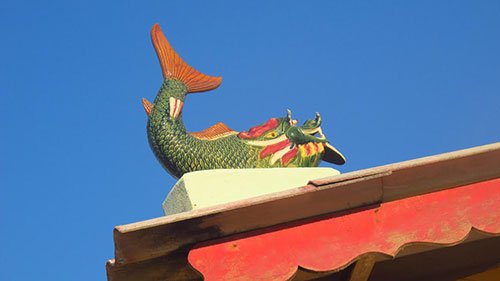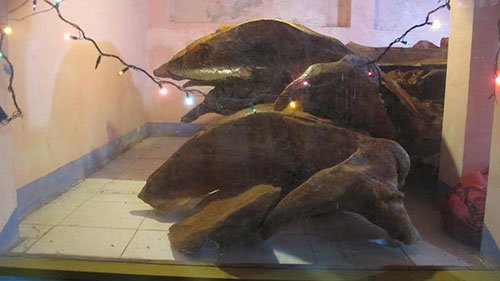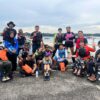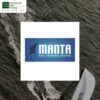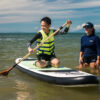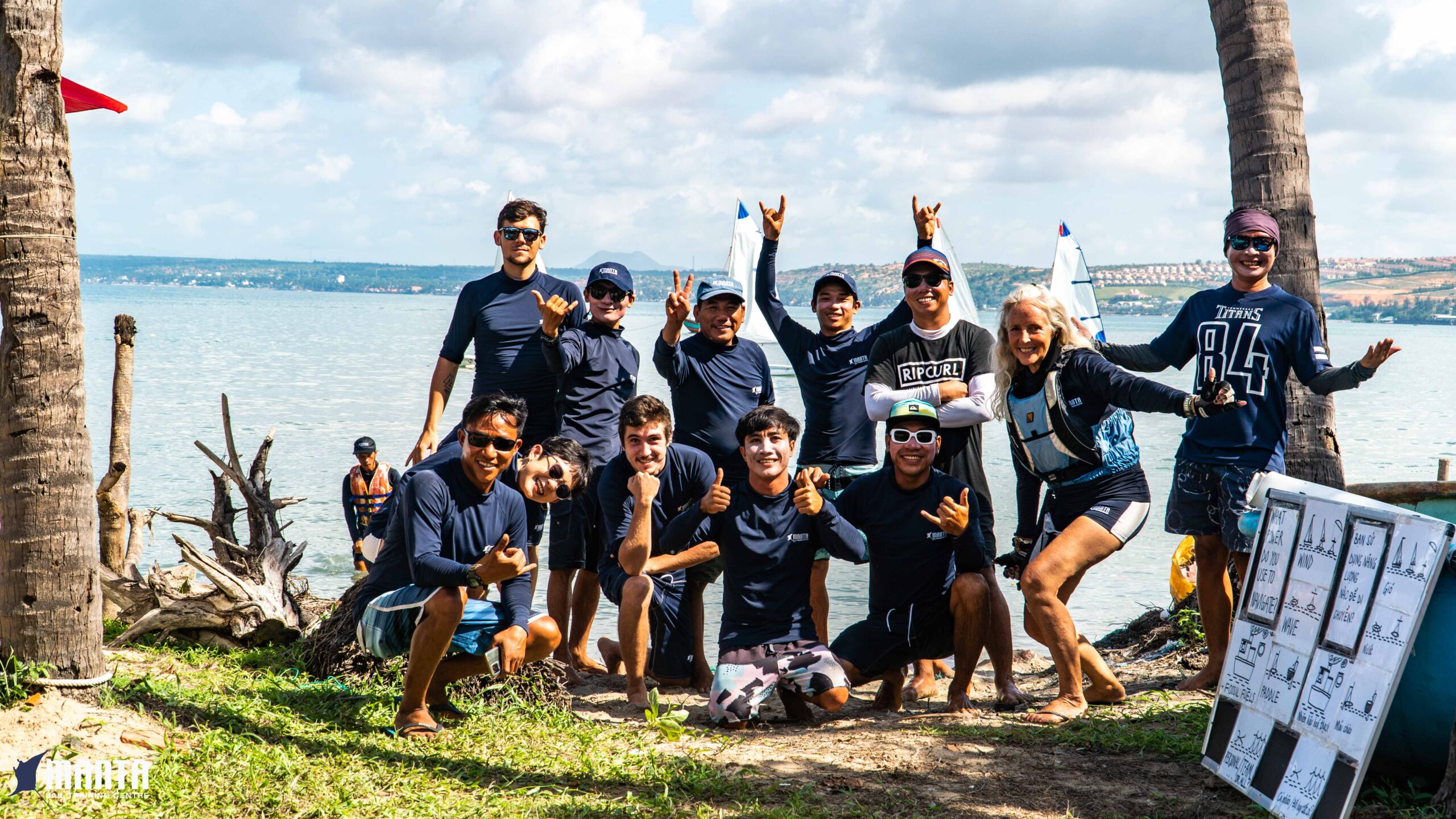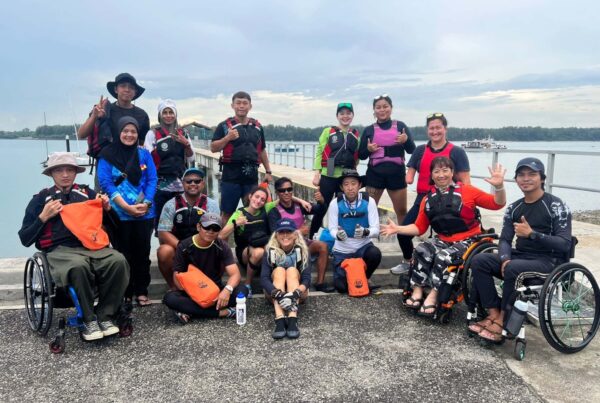The road to the whale temple on the point winds through the quiet fishing village of Mui Ne, then climbs up a white sandy path to where the temple looks across the bay. We park the Hondas and wait for the temple keeper to arrive. The famous red sand hills of Mui Ne color the horizon. Blue and red fishing boats crowd the bay below. The morning sun burns, slowing our movements and amplifying the sound of cicadas. Shadows of spindly eucalypts and spikey cactus cover the sandy ground. The cool open concrete structure of the temple is regularly maintained but rarely used. An open central area is empty, but during festivals it can hold about four dragon boats. The altar room where sacred whale bones are kept has a solid plank red door with a heavy padlock. I press my eye to the gaps in the planks to see the tinkle of red temple lights. The whale bones in there could provide valuable data on whales in these waters, as scientific data on whales in Vietnam is almost non-existent. Scientists have carried out only one international research here in the last 20 years because of the large cost of ocean field research.
But Vietnam’s unique whale temples contain a sea of information, so marine biologists can build a better picture of the big mammals of the East Sea (South China Sea). In 10 minutes the keeper Hai arrives. Swarthy and short, ruddy round face, clean brown flat feet of a fisherman. The first thing he does is unlock the altar rooms and refresh the candles and incense. He is methodical and quick, bowing and muttering a moment at each sand filled incense pot, a routine he has done every day for eight years. The altars are labelled with blue marker pens. One of the deities takes my eye. It’s a blue pottery man – like some kind of water demon – holding a flag. Mischievous and nimble. The central room holds the main display for worship. A five meter long glass cabinet housing two whale skulls, jawbones and vertebrae. Millions of fishermen along the country’s southern coastline, worship the whale (Ca Ong – which means old man fish) and whale bones are stored in their temples. Studying these bones will help marine biologists identify marine animal species that live in these waters. Hai’s caretaking duties take five minutes and then leaving the blue man in the dark except for tiny tinkling temple lights and candles he locks the altar room. The incense and candles are lit and now he is ready to talk to us.
With me is Julia Shaw and La. Julia is a Mui Ne based sailor and marine conservationist who employs local fishermen to help run her sailing business. The head sailor, La, has known the temple keeper Hai all his life. Nguyen Quan La, 28, is a Mui Ne Village local. Before joining the national sailing team with Julia he was a fisherman for seven years. The temple keeper, Do Van Hai, is a member of the nearby fishing village’s People’s Committee. I ask questions in English and La translates. Hai says the temple is usually closed except for festivals that are held every three years. The people of the fishing village contribute to the upkeep of the temple and the cost of the festival. At the festival they ask for the whales’ protection at sea. Hai says all fishermen respect the whales. If they see a dead one they always tow it in and bury it. But if whales strand themselves on the shore the fishermen try to save them by pulling them out to sea either by hand or by boat, he says. Hai also brings out a handful of smaller bones including teeth. They turn out to be the teeth and ear bones of dolphins.
We go into the whale bone altar room for a closer look. I burn some incense for the fishermen then some more for whales then Hai locks up, we thank him and say goodbye. Near the temple under a gum tree is a 10m whale grave with a short corrugated iron fence. La says the 10 ton leviathan buried there was discovered at sea by a fisherman, towed in and buried using a crane and a digger three years ago. They dug it up last year but it was so big the meat was still rotting, so they covered it up again. It will be exhumed again in two years and there will be a festival.
“I have seen a lot of whales and dolphins. On calm days they chase the little fish close to the surface. They come out of the water with their mouth open,”
La says talking of his fishing days.
“All the fishermen respect the whale.”
According to La there is a legend about the whales that the old men used to tell him. Many years ago a fishing boat sank in a storm in rough seas. Many of the fishermen drowned and then a whale came. The next morning they woke up on a beach on an island thanks to the whale that had rescued them. It is customary for fishermen to tow dead whales to shore to hold a funeral. Three years later they dig it up, clean the bones and put them in clay jars in the temple, La says. Hai or La can’t identify the whale species in the temple so I find someone who can.
Lindsay Porter is an expert in coastal/tropical delphinids (dolphins) in Asia. She works for University of St Andrews in Scotland but is based in Hong Kong and Borneo. With long blonde hair and very pale Scottish skin, Lindsay gets burnt easily in the equatorial sun. I talk to her via email and tee up a meeting next time she is in Australia. She’s very interested to see my photos of the temple whale bones. In a broad Scottish brogue she says, “We don’t know anything about what happens [with whales] in Vietnam. Nobody does active research there. We had a brief exchange agreement with the Institute of Oceanography in Hanoi, but that was a long time ago.” She can tell by my photos of the whale bones that they belonged to baleen whales. The domed skulls and long curved jawbones designed to hold the massive baleen filter system give it away. She makes a rough identification then references it against photos from the British Natural History Museum. She tells me the two whales are Brydes whales, both quite young specimens judging by the size, but she can’t tell me much more. So little is known about the whales in the East Sea. To bolster the research and skirt the problems of costly ocean research, Lindsay is part of a new project with seven Asian countries including Vietnam to find out the health of marine mammals in the East Sea area. The Marine Stranding Mammal Network aims to coordinate common research through partnering with Asian countries and collecting data from dead or stranded whales or dolphins. Vietnam’s whale temples provide unique opportunities, as the practice of towing in whales to hold funerals still continues. It’s a cruel paradox, but she says the two Brydes whales in the temple were most likely killed in Vietnamese fishing nets, victims of by-catch, then other boats came along later and found them. The whales and the fishermen chase after the same thing – schools of fish – so they coincide in the same areas, follow the same ocean currents, she says.
“Seventy per cent of protein consumed in the Asian diet comes from the ocean. Far more people are out there fishing for their families. Sustenance fishing. Literally millions of people.”
It’s logical but tragic that whales are the victims of by-catch in Vietnam. As well as the Marine Stranding Mammal Network Lindsay sits on two committees: SEAMAM which was formed so developing countries can access the latest technology and science for marine mammal research; and the International Whaling Commission Scientific Committee that makes recommendations for the Whaling Convention. Her main research is with the pink dolphins of Hong Kong. It is an urban coastal habitat in the busiest port in the world with “disgusting pollution”. She compares this unhealthy population in Hong Kong to the healthy pink dolphins at a second site in pristine Borneo. It seems that everyone, fishermen, whales and dolphins, needs protection. Let’s hope that Ca Ong, the prayers at the whale temple and the research can help Vietnam’s sacred whales.
By Mic Smith in Mui Ne
